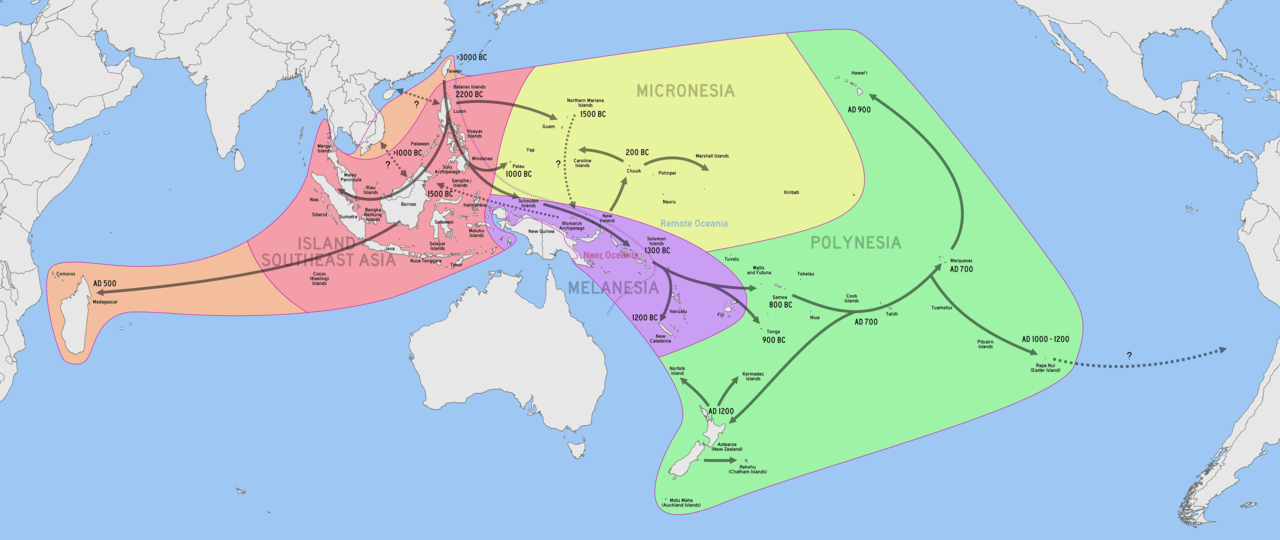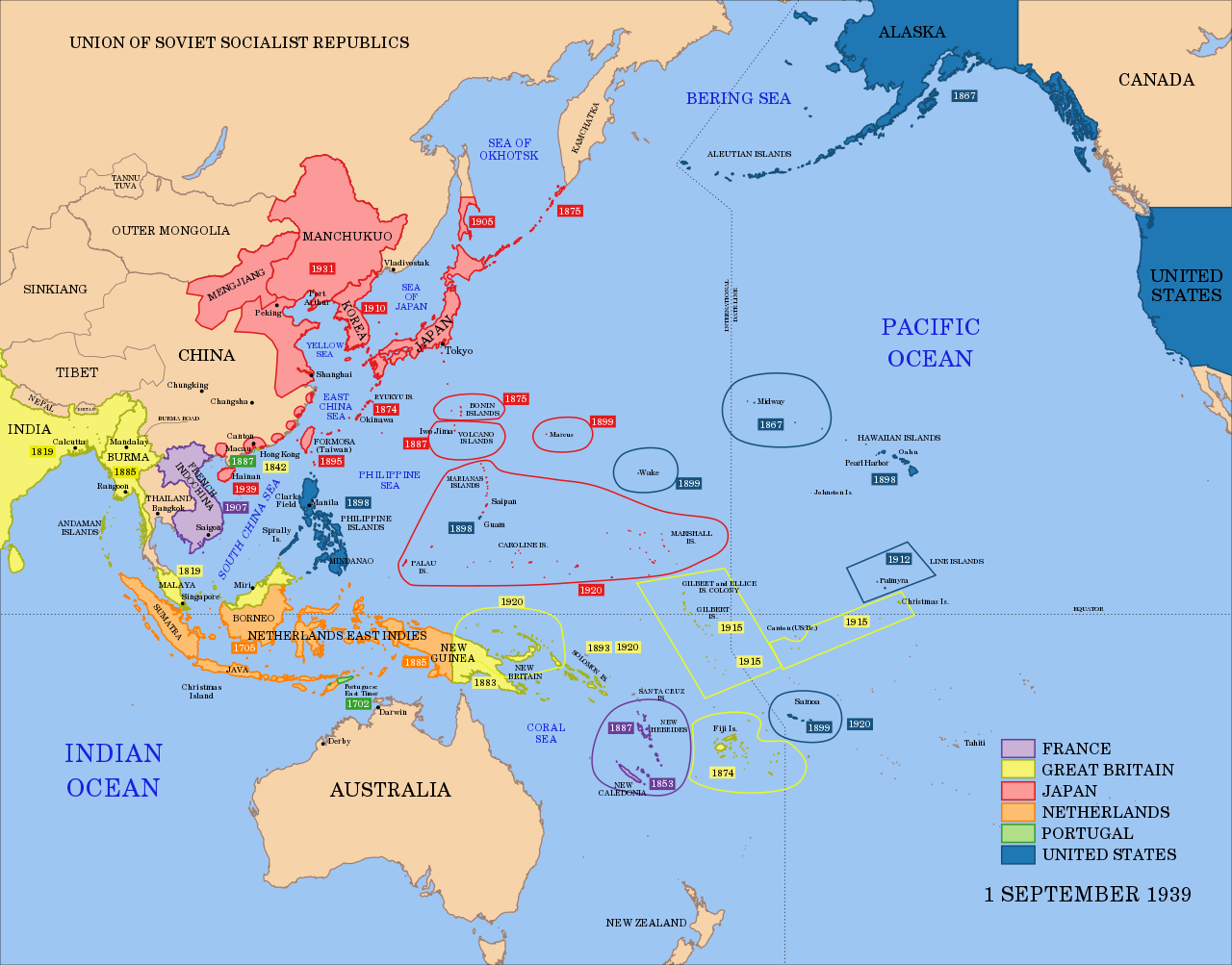More languages
More actions
Oceania is a geographical region in the southwestern Pacific composed of thousands of islands commonly divided into four culturally distinct subregions known as Australasia, Melanesia, Micronesia, and Polynesia.
According to the Asia Society Policy Institute, "Oceania is increasingly seen as an important geostrategic region among mounting great power competition and is at the forefront of the battle against climate change."[1]
Regions
Micronesia, which lies north of the equator and west of the International Date Line, includes the Mariana Islands in the northwest, the Caroline Islands in the center, the Marshall Islands to the west and the islands of Kiribati in the southeast.
Melanesia, to the southwest, includes New Guinea, the world's second largest island after Greenland and by far the largest of the Pacific islands. The other main Melanesian groups from north to south are the Maluku Islands Archipelago, the Bismarck Archipelago, the Solomon Islands archipelago, Santa Cruz, Vanuatu, Fiji and New Caledonia.
Polynesia, stretching from Hawaii in the north to New Zealand in the south, also encompasses Tuvalu, Tokelau, Samoa, Tonga and the Kermadec Islands to the west, the Cook Islands, Society Islands and Austral Islands in the center, and the Marquesas Islands, Tuamotu, Mangareva Islands, and Easter Island to the east.
Australasia comprises Australia, New Zealand, the island of New Guinea, and neighbouring islands in the Pacific Ocean.
History

There are competing theories regarding the specifics of the prehistory of Oceania and much remains unknown about the region's prehistory. It is commonly believed that the islands of the Pacific were originally migrated to from Southeast Asia by two different groups of people at widely separated points in time. The first group reached New Guinea and Australia roughly 40,000–60,000 years ago. It would be more than 30,000 years before the descendants of a second wave of Southeast Asian peoples, together with the Melanesians with whom they interacted, began migrating further throughout Oceania.[2]
European colonization
Exploration of the region by Europeans began in the 16th century when Portuguese explorer Ferdinand Magellan landed on the Mariana Islands. England, France, Germany, and Spain became major colonial powers in the region.
Second World War

During the Second World War, the Pacific theater was a major battle zone between Japan and the Allied powers. As a result of the military campaigns in Oceania, many territories were given to Allied forces, such as the Solomon Islands (United Kingdom), the Northern Mariana Islands (United States), and the Marshall Islands (United States).[3] After the United States acquired Japanese colonies in the northern Pacific, it established a major military facility in the Marshall Islands and expanded its bases in Guam and Hawaii.[4]
Nuclear testing
According to a Monthly Review Online article, the US conducted 105 nuclear tests in the Pacific, mainly in the Marshall islands, between 1946 and 1962, as part of its program to develop thermonuclear bombs. Operational weapons were sometimes tested, including a submarine-launched war head. One test in 1952 completely vaporised the island of Eluglab. In 1954, a thermonuclear bomb tested on Bikini atoll exploded with force of 15 megatons – over 1,000 times bigger than the bomb dropped on Hiroshima. The radioactive cloud engulfed a Japanese fishing boat about 80 miles away in a white powder that poisoned the crew. One died from the exposure seven months later and 15 more in following years. The radioactivity affected the drinking water and food and in 2005, the US National Cancer Institute reported that the risk of contracting cancer for those exposed to the fallout was over one in three.[5]
Britain tested 40 thermonuclear bombs on an islands in the Kiribati group between 1957 and 1962. Troops from Britain , Fiji (then a British colony), and New Zealand worked on the tests. Many were harmed by radiation and other causes. The author of the article in Monthly Review noted, "As usual, the locals were treated badly and their water and lands polluted."[5]
France conducted 41 atmospheric nuclear tests between 1966 and 1974 in French Polynesia. It then conducted 140 underground, primarily of thermonuclear bombs, until 1996. One of the islands used was subject to cracking. In an act of state terrorism, French secret service frogman killed a photographer when they bombed a Green Peace protest ship in Auckland harbour on its way to the French nuclear testing area.
In 2014, the Marshall Islands attempted to sue the US and eight other nuclear armed nations, for failing to move towards nuclear disarmament as required by the Nuclear Non-Proliferation Treaty. A US Court dismissed the suit in 2017.[5]
References
- ↑ “Oceania.” Asia Society. Accessed 2022-09-15. Archived 022-09-15.
- ↑ “Oceania, 8000–2000 B.C.” In Heilbrunn Timeline of Art History. New York: The Metropolitan Museum of Art, 2000. Archived 2022-09-15.
- ↑ “Australia and Oceania: Human Geography | National Geographic Society.” Nationalgeographic.org.
- ↑ “Oceania: Islands, Land, People.” Culturalsurvival.org. Archived 2022-03-24.
- ↑ 5.0 5.1 5.2 Toohey, Brian. “The United States- the Pacific Bully” MR Online. June 25, 2022. Archived 2022-09-15.
